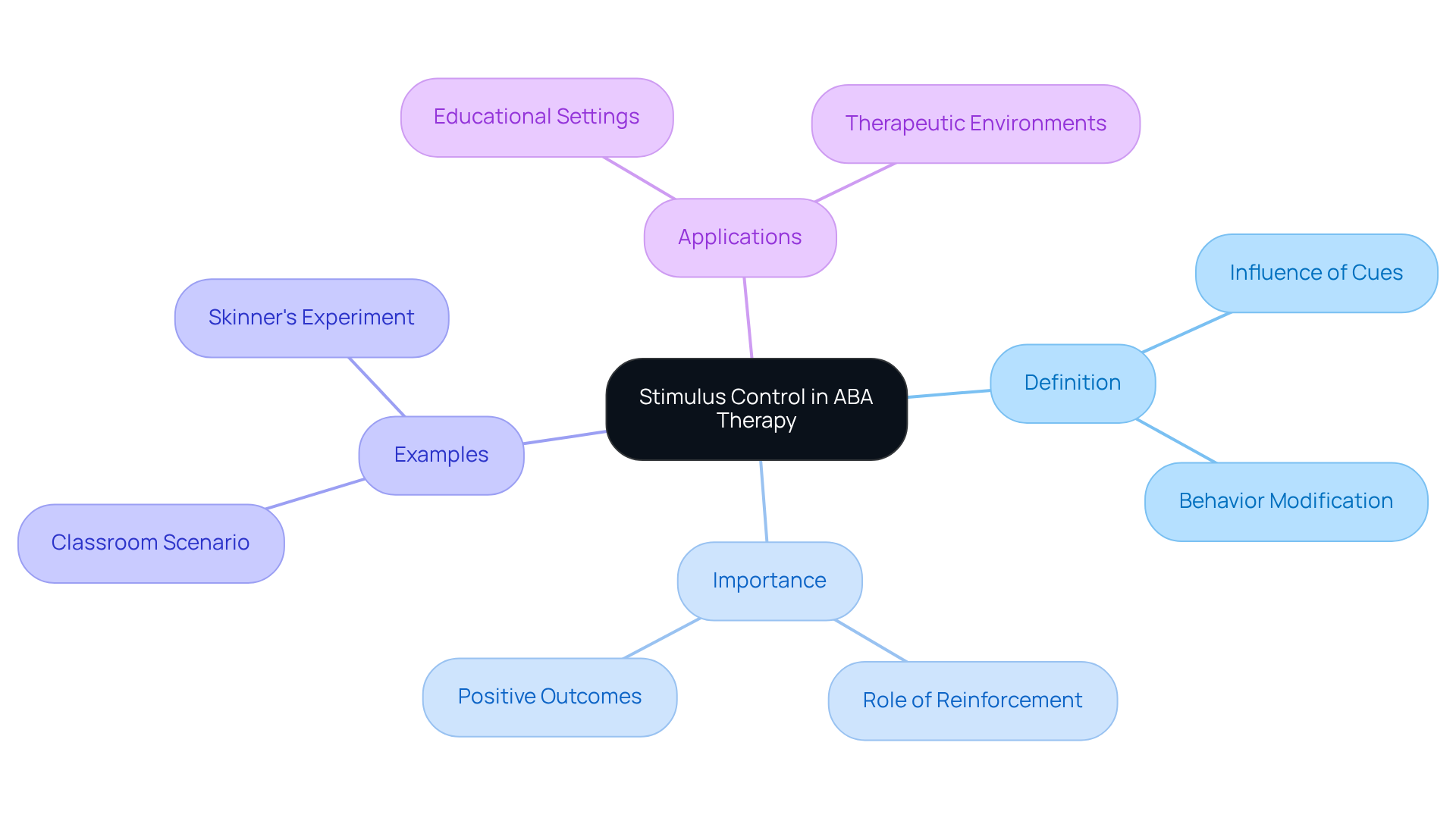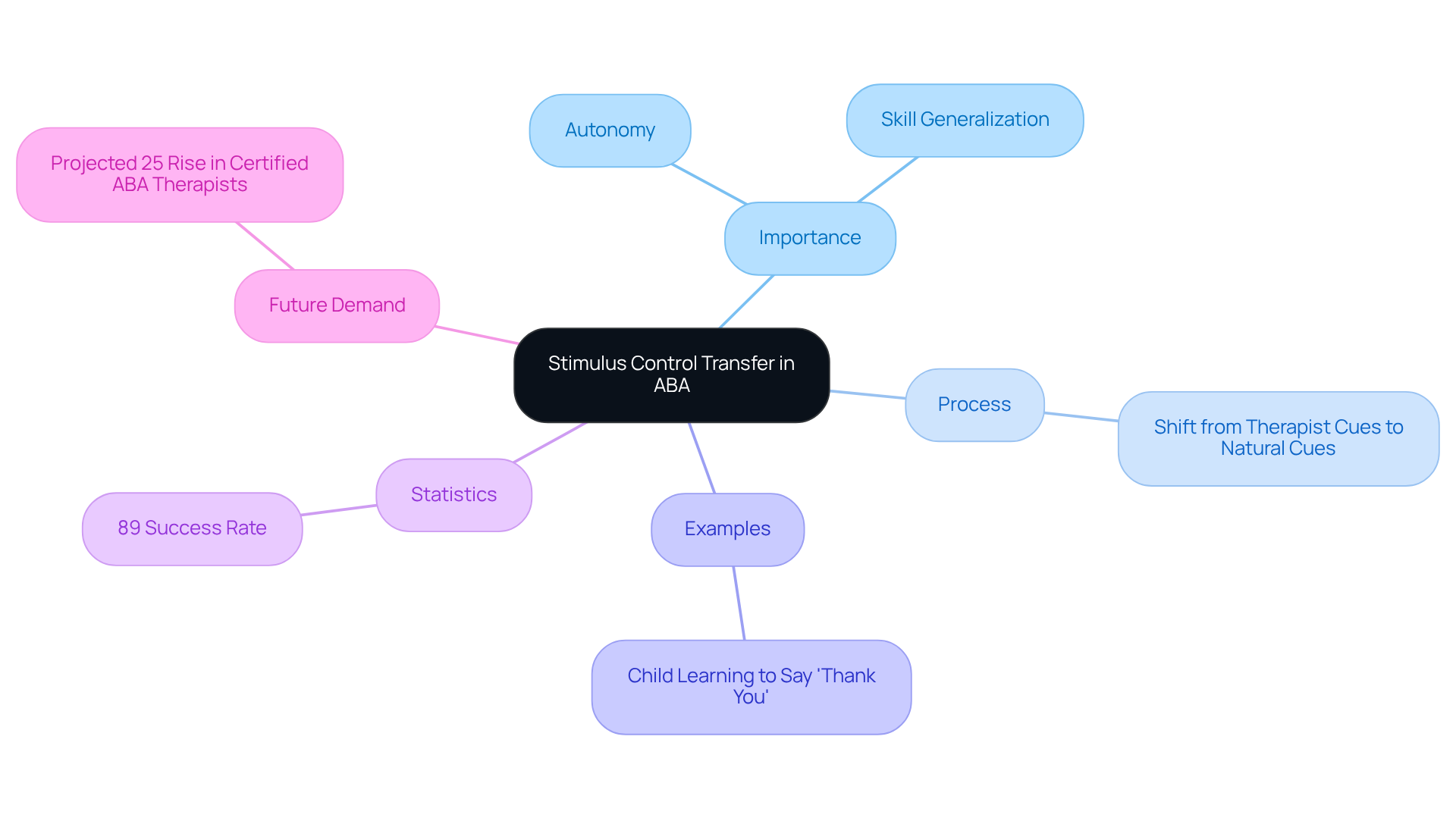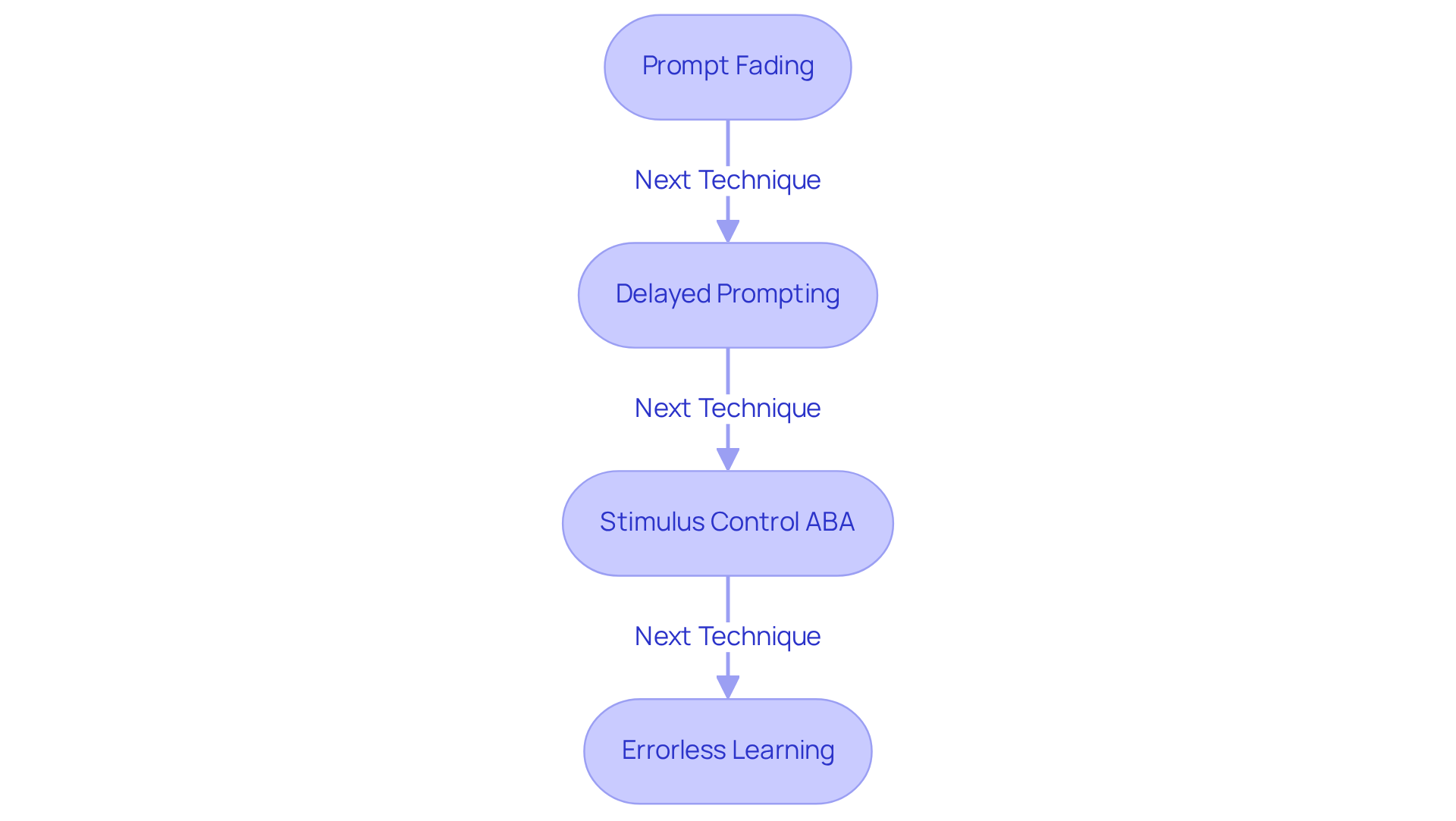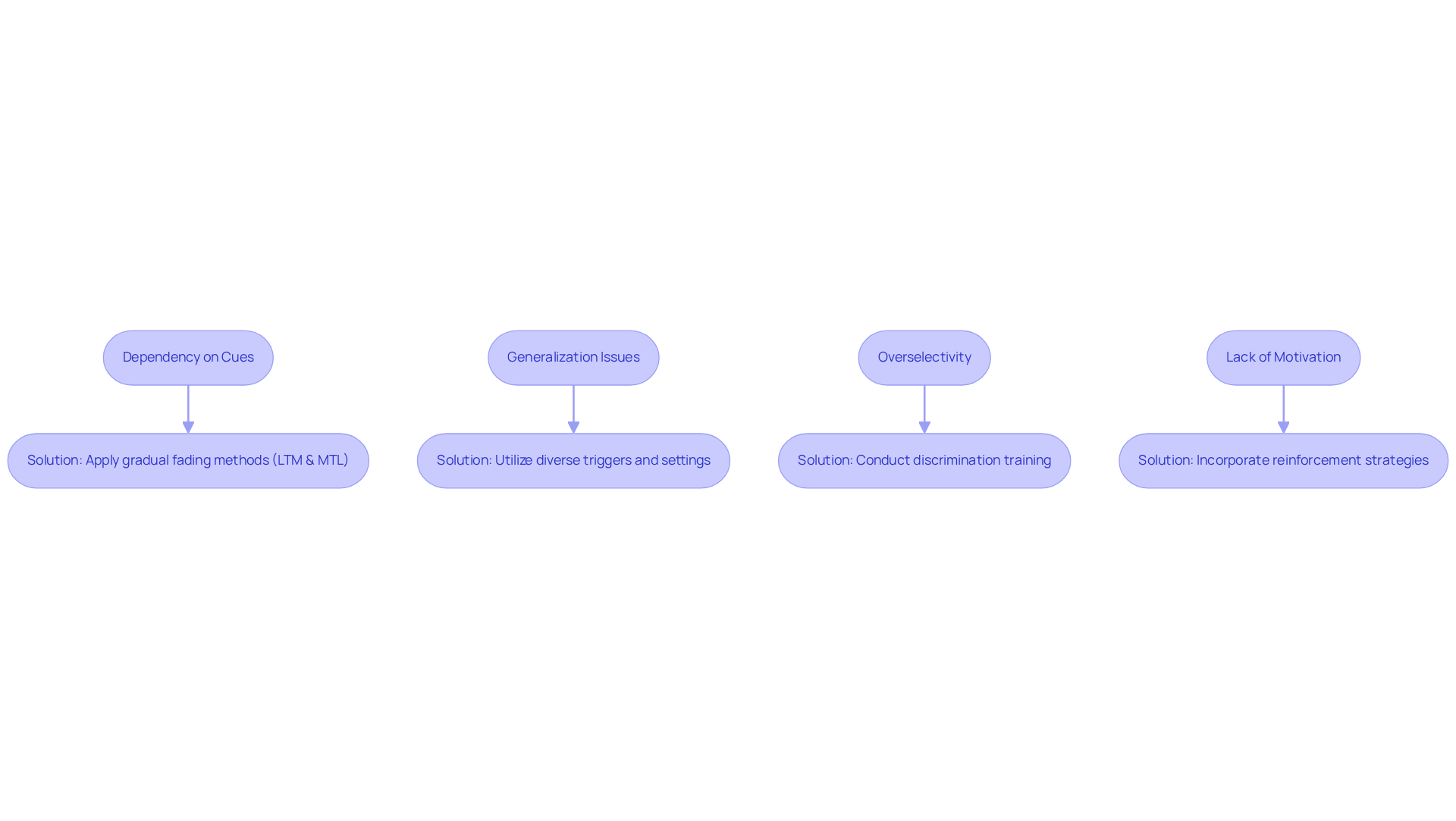June 30, 2025

The article centers on mastering stimulus control within Applied Behavior Analysis (ABA) therapy, highlighting its techniques, significance, and the challenges involved. Effective stimulus control is crucial for behavior modification, as it utilizes cues to influence actions. Moreover, it is essential to transition control from therapists to natural cues to foster independence in individuals. This process is supported by various techniques and solutions to common challenges encountered along the way.
Understanding the intricacies of stimulus control in Applied Behavior Analysis (ABA) therapy is essential for shaping effective behavioral interventions. This concept not only influences how behaviors are reinforced but also plays a pivotal role in fostering independence among individuals undergoing therapy.
However, mastering the techniques of stimulus control transfer presents unique challenges that can hinder progress.
How can practitioners effectively navigate these obstacles to enhance learning outcomes and promote self-sufficiency?
In Applied Behavior Analysis (ABA) therapy, stimulus control ABA is a critical phenomenon where the probability of a specific action is influenced by the presence or absence of particular cues. For example, a child may learn to raise their hand in class when the instructor is present, as this serves as a distinguishing signal, while avoiding this action when the teacher is not there. This concept is essential for effective conduct modification, enabling practitioners to systematically shape and reinforce desired behaviors. By creating clear control over prompts, therapists can design environments that promote learning and adaptive actions, ultimately enhancing the effectiveness of interventions.
Recent studies underscore that actions are more likely to be repeated when they yield positive outcomes, emphasizing the importance of stimulus control ABA in fostering favorable learning environments. As B.F. Skinner aptly noted, "Conduct is a function of its consequences," highlighting the pivotal role of reinforcement in modifying behaviors. For instance, research indicates that children who receive immediate praise for raising their hands in class are more inclined to repeat this behavior, showcasing the power of reinforcement in shaping actions.
The practical applications of stimulus control are evident in various settings, such as classrooms where educators use specific cues to signal preferred behaviors. By employing visual aids or verbal prompts, educators can effectively direct students toward appropriate actions, thereby enriching their learning experience. This approach not only promotes personal development but also contributes to a supportive classroom atmosphere, reinforcing the notion that actions are significantly influenced by environmental factors. Skinner's experiment with the Skinner Box exemplifies these principles, demonstrating how behaviors can be shaped by consequences and further validating the importance of stimulus control ABA in therapy.

Stimulus control ABA transfer is a cornerstone of Applied Behavior Analysis (ABA) therapy, enabling the shift of control over a behavior from a therapist's signal to a natural environmental cue. This transition is essential for promoting autonomy in individuals, allowing them to respond appropriately to real-world circumstances without relying on external cues.
For instance, a child who learns to express gratitude by saying 'thank you' when prompted by a parent should ultimately be able to do so independently when receiving assistance from others. This process not only enhances the generalization of skills but also promotes self-sufficiency, a primary objective of stimulus control ABA therapy.
Statistics indicate that ABA therapy has an over 89% success rate in treating children with autism, particularly when initiated at a young age. This emphasizes the significance of efficient control transfer in achieving meaningful results. By concentrating on this transfer, therapists can significantly improve the quality of life for individuals with autism, ensuring they develop essential skills for independence and daily functioning.
As the demand for certified ABA therapists is projected to rise by 25% by 2026, the importance of effective methods, including control transfer, becomes even more evident.

Effective stimulus control transfer in ABA therapy can be achieved through several techniques:
Prompt Fading: This involves gradually reducing the level of assistance provided to the individual. For example, when encouraging a child to say 'hello' upon encountering someone, the therapist might start with a complete cue, move to a partial cue, and ultimately reduce to no cue at all.
Delayed Prompting: By introducing a delay before offering a prompt, this technique encourages the individual to respond independently. Such an approach builds confidence and reduces reliance on immediate cues.
The concept of stimulus control ABA is crucial in understanding behavior modification. Stimulus control ABA is a technique that modifies the stimuli to make the correct response more apparent. For instance, visual aids or cues can be utilized that gradually become less prominent as the individual learns the desired behavior.
Errorless Learning: Tasks are designed to minimize the likelihood of mistakes, thereby reinforcing correct responses and reducing frustration. This method often includes providing immediate feedback and support throughout the learning process.

While stimulus control transfer is a powerful technique, several challenges may arise:
Dependency on Cues: Individuals may become excessively dependent on cues, making it challenging to attain independence. Solution: Apply gradual fading methods, such as the Least-to-Most (LTM) and Most-to-Least (MTL) strategies, to systematically lessen dependence on cues over time. Studies show that effective prompt fading within the framework of stimulus control aba fosters long-lasting skills and independence for individuals with special needs.
Generalization Issues: Skills learned in one context may not transfer to another, limiting their practical application. For instance, children in ABA interventions often demonstrate significant improvements in cognitive ability, but these gains may not generalize to different settings. Solution: Utilize diverse triggers and settings during training to encourage the transfer of skills across various environments with the application of stimulus control ABA. Incorporating the Life Centered Education (LCE) curriculum, which includes 1,200 lesson plans, can facilitate the achievement of Individualized Education Program (IEP) goals in diverse settings.
Overselectivity: Individuals may concentrate on unimportant cues, hindering their ability to respond appropriately. This can be particularly problematic in environments with multiple distractions. Solution: Conduct discrimination training to assist people in learning to differentiate between relevant and irrelevant stimuli. This approach, utilizing stimulus control aba, has been shown to enhance engagement and motivation, leading to improved task performance.
Lack of Motivation: If people do not recognize the value in the behavior, they may not participate. This is a common barrier in ABA therapy, where intrinsic motivation can be overshadowed by external prompts. Solution: Incorporate reinforcement strategies that align with a person's interests and motivations, ensuring that the learning process is engaging and rewarding. Evidence suggests that external rewards can enhance intrinsic motivation, countering critics' claims that they diminish it. By leveraging these strategies, practitioners can effectively support individuals in achieving greater independence and successful skill acquisition.

Mastering stimulus control in Applied Behavior Analysis (ABA) therapy is essential for effectively guiding behavior modification and promoting independence in individuals. By understanding how specific cues influence actions, practitioners can create environments that foster learning and adaptive behavior. The significance of this concept lies not only in its ability to shape responses but also in its role in enhancing the overall effectiveness of therapeutic interventions.
The article highlighted several key aspects of stimulus control, including:
The challenges of:
were addressed, along with practical solutions such as:
These insights underscore the intricate relationship between stimulus control and successful outcomes in ABA therapy.
In a broader context, the mastery of stimulus control techniques is vital for improving the quality of life for individuals receiving ABA therapy. As the demand for skilled practitioners continues to grow, it becomes increasingly important to implement effective methods that facilitate independence and skill acquisition. Embracing these strategies not only enhances the learning experience but also empowers individuals to thrive in real-world situations, ultimately leading to more fulfilling lives.
What is stimulus control in ABA therapy?
Stimulus control in ABA therapy refers to the phenomenon where the likelihood of a specific behavior is influenced by the presence or absence of particular cues or signals.
Can you provide an example of stimulus control?
An example of stimulus control is a child who learns to raise their hand in class when the instructor is present, as the instructor serves as a cue for this behavior, while the child may refrain from raising their hand when the instructor is not there.
Why is stimulus control important in behavior modification?
Stimulus control is essential for effective behavior modification because it allows practitioners to systematically shape and reinforce desired behaviors by creating clear control over prompts and designing environments that promote learning and adaptive actions.
How does reinforcement relate to stimulus control?
Reinforcement plays a crucial role in stimulus control, as actions are more likely to be repeated when they result in positive outcomes. For instance, children who receive immediate praise for raising their hands are more inclined to repeat this behavior.
What are some practical applications of stimulus control?
Practical applications of stimulus control include using specific cues in classrooms, such as visual aids or verbal prompts, to direct students toward preferred behaviors, thereby enhancing their learning experience and fostering a supportive classroom atmosphere.
How does Skinner's experiment relate to stimulus control?
Skinner's experiment with the Skinner Box demonstrates how behaviors can be shaped by consequences, validating the importance of stimulus control in ABA therapy by showing that actions are significantly influenced by environmental factors and reinforcement.
Our expert recruitment strategies and AI-driven sourcing ensure that you receive top-notch candidates quickly, without compromising on quality. Whether you’re looking for BCBAs, Clinical Directors, or RBTs, we’ve got you covered.